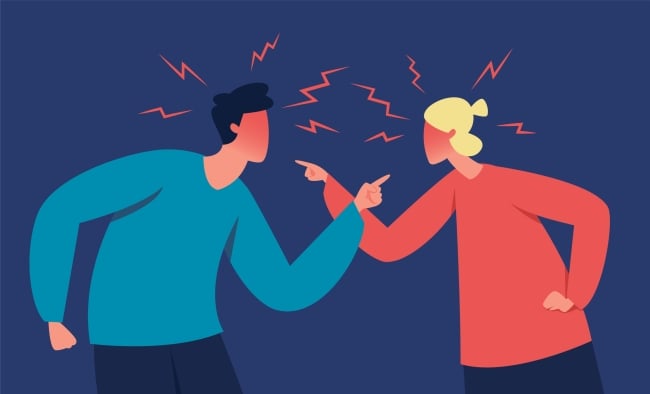You have /5 articles left.
Sign up for a free account or log in.

vatrushka67/Istock/Getty Images Plus
The past several years have brought their share of stresses and challenges to the college classroom, including an increase in difficult conversations that instructors must navigate while keeping students engaged in their courses and learning. Although discussions and research about how to deal with such challenging discussions have been occurring for years, in recent semesters, we have expanded our support at the Columbia Center for Teaching and Learning for instructors who are grappling with these issues. We have developed an on-demand resource to help faculty determine the appropriate responses to difficult situations and incidents in their classrooms that focuses on an acronym that can act as a framework: HOT, which refers to moments in a classroom context that are Heated, Offensive and/or Tense.
While “hot moments” is a phrase commonly used to describe any moments of challenge or difficulty that may arise, HOT as an acronym makes important distinctions among the different kinds of situations instructors are facing, as well as the various approaches they might employ to deal with them. Parsing out the nuances can help instructors feel better equipped and prepared to handle such classroom moments, because they are, in fact, different in nature and may require distinct pedagogical responses. In this article, we will untangle the acronym and explore some of those nuances.
HOT Moments Disembroiled
If you are an instructor, disembroiling HOT moments will allow you to more carefully consider your potential responses to a particular situation. While certainly some responses can be appropriate for all three types of moments—almost any moment can benefit from a reflective pause, for instance—it can be helpful for instructors to have different strategies ready for when these moments arise. Because they will arise, and valuable learning can, in fact, occur during them. But without a proper response, those learning opportunities can be lost.
One important note about this acronym and our use of “moment”: throughout this article, we use “moment” to refer to the specific moment within the classroom context. Its use does not refer to a moment that may have contributed to the cause of that classroom experience. There is great complexity and nuance within the factors and causes outside of the classroom context that “moment” could not possibly capture.
We must also acknowledge that while distinguishing between heated, offensive or tense moments has value, such situations are not mutually exclusive. Offensive moments can get tense, and tense moments can get heated. What’s crucial is having the tools to create space—both mentally and emotionally—to identify a particular moment and consider what response strategy best aligns with the situation at hand. That’s where the HOT acronym can become useful, as it can help you find that space and determine how best to proceed when things get challenging. Of course, understanding the context of the moment will also help you identify the best response, which requires knowing yourself, your students and your course.
Heated Moments
Perhaps the easiest moments to identify are those that are clearly heated. They are typically characterized by an obvious rupture in the class, often evidenced through name calling, shouting, accusations or rising tensions. When faced with a heated classroom moment, you should consider the best way to deal with it and, equally important, how learning can remain possible for all your students.
When responding to heated moments, sometimes the best thing we can offer our students and ourselves is a reflective pause. We can provide an opportunity to consider what happened, what is causing the heat, and how we can proceed together as a learning community. So, we might say something like: “I understand emotions are running high right now. It’s OK to have strong feelings, but it’s not OK to treat each other poorly. Let’s all pause for a moment, take stock of how we’re feeling, and think about how we move forward together.”
We may also have the chance to return to any previously established community agreements or discussion guidelines for the class. As a group, are we meeting those agreements or guidelines? If not, should we revise or reflect on them?
Maybe the rupture happened just as the class was packing up and heading out the door. While certainly not ideal, that’s OK. What becomes most important in such situations is that we provide a response—whether online or in person at the beginning of the next class. No matter the how or when of your response, remind your students that there can still be productive learning and growth, and that you are committed to ensuring that all students feel welcome and are continuing to learn.
Offensive Moments
Offensive moments can arise in many ways. Perhaps someone has used a racial slur or read one aloud from a text. It could be that someone has made an offensive comment about a particular group or individual or an inappropriate “joke” at their expense.
Your response to an offensive moment can determine how a learning environment shifts, as such a moment can easily escalate and become heated. If the moment is left unaddressed or unacknowledged, it is possible some members of the classroom community may sit silently or withdraw from the discussion. Either scenario threatens your students’ continued learning.
When responding to an offensive moment, you can again return to community agreements or discussion guidelines. You can also help the person or people responsible take ownership of their actions by acknowledging that they have responsibility not only for the motive behind their words or actions but also for their impact, intended or not.
In addition, when an offensive moment occurs in response to course material—say, when a student has presented an offensive opinion or harmful stereotype as fact—it can be helpful to ask your students to return to a particular text or class material that can help refocus the discussion and ground it.
Tense Moments
Moments of tension can be challenging to identify. They can occur when the classroom goes quiet after a particular comment or remark, with students appearing noticeably uncomfortable, or they can manifest as one of those hard-to-define shifts in the class vibe or feeling.
Tense moments may be related to the coursework or may be a response to situations outside or beyond the classroom environment. At the local or campus level, for example, certain initiatives or guest speakers on campus may motivate students to bring questions or concerns into the classroom for discussion, regardless of the course content. Tense moments can be the result of national or global issues such as election cycles or current political events that students raise in the classroom—potentially without consideration of the variety of viewpoints and perspectives present. In those instances, you may struggle with the level of control you feel you have over the situation.
Tense moments can bring their own distinct challenges, particularly if the moment is not recognized and addressed in real time. If you are made aware of the moment after it has occurred—for example, if a student emails you following the class session—offer a one-on-one meeting to discuss with them how you might help them move forward. Given the power dynamics that are involved in the meeting, you should also help students feel prepared by sharing meeting goals and expectations beforehand.
When a tense moment arises outside the context of class material, you may feel that you have less agency or grounding in terms of a response to the classroom community. Taking time for reflection, and even admitting that you, too, are grappling with the particular situation and are unsure of how to respond, are all appropriate and valuable responses. What is most important is that, as the instructor, you make space to recognize and acknowledge how a particular climate or event may be impacting students’ learning.
Know Yourself, Know Your Course
HOT moments can disrupt learning and create distance in the classroom. In fact, some such moments may perpetuate systemic harm and biases against some students. They do not provide learning opportunities and should be called out for what they are. Other moments, however, have the power to create productive and powerful learning and growth opportunities, given a careful response,
Being able to identify in real time the type of moment—whether Heated, Offensive or Tense— can help us respond and help ensure that students’ learning can continue. Beyond knowing the types and possible response strategies, however, we must also work to deepen our self-awareness—in other words, we must know ourselves and our courses.
Consider what topics or types of comments might trigger a reactionary response in you, as being prepared ahead of time can help you better respond in the moment. Additionally, consider different elements of your course: What readings, assignments, or topics have sparked HOT moments in previous courses? How did you respond in the moment? What might you want to do differently?
Also, try to be as prepared as possible for HOT moments that will be more unanticipated yet also need an immediate response—such as offensive comments or remarks made outside the scope of course material or incidents influenced by a tense sociopolitical climate or other events outside the classroom context. It can be helpful to reflect on what you would do if these situations occurred: How would you prepare to facilitate difficult conversations in your classroom? What is your approach for creating space for difficult dialogues and inviting diverse perspectives while keeping the focus on the class learning goals?
Last, spend time early in the semester fostering a classroom environment of trust. Every interaction with students offers an opportunity to create a little bit of that—or a whole lot of distance. Prioritizing a sense of community, rapport and learning can help the class as whole move forward and recover when HOT moments arise. And no matter the moment, whether it be heated, offensive, tense or some combination of the three, it is important to work with your students to respond and ensure that learning remains possible for every one of them.




